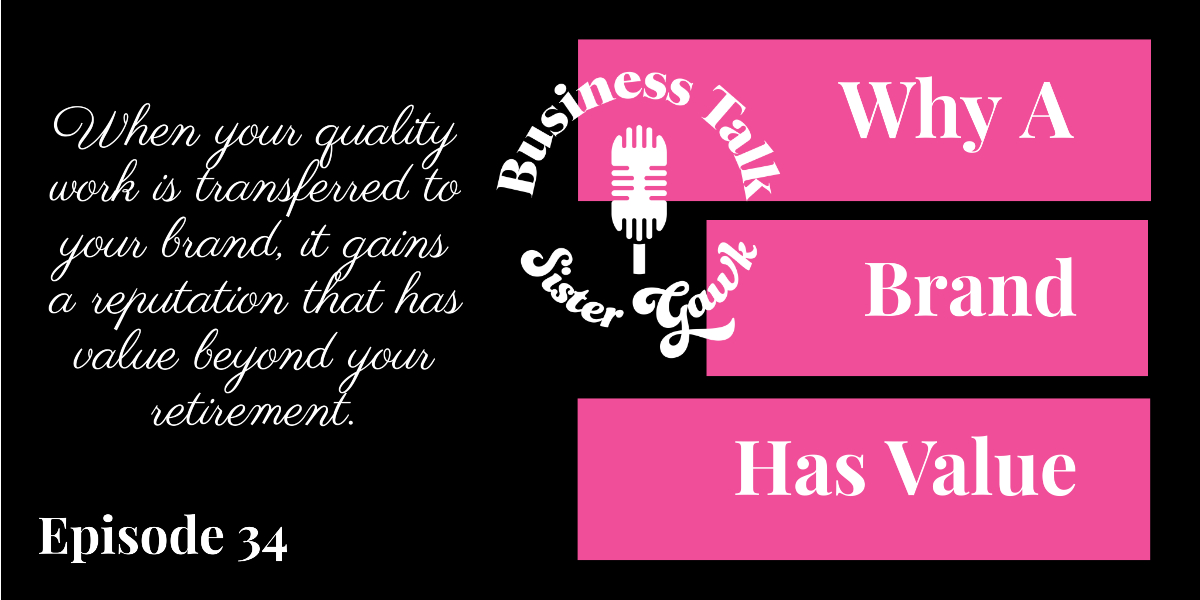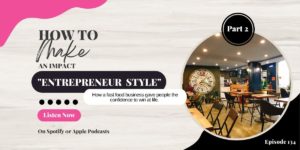Have you ever understood why someone is willing to pay more for almost the exact same product when the only difference is the brand? This is the topic of discussion this week. We dig into why a brand retains value that people are willing to pay for.
Welcome to Business Talk Sister Gawk I’m Bekkah! And I’m Ruthie! And today we are talking about why a brand has value. I’m super excited to talk about this because it’s kind of an interesting topic to look at. There are so many case studies! We’re gonna get into a lot of different examples today of what that looks like. The biggest question a lot of people have when they’re like, “Why do people say you have to have a good brand?” “What’s valuable about it?” “Why is it people pay so much money for something that might be the same thing!”
A Case Study Example of Brand Value Using the Textile Industry
We’re excited to talk about the concept of “the same thing” first because I think it’s really important to understand where we’re starting from. Because a lot of people will tell you, “Oh, well, it’s because it’s better quality or it’s because it’s this,” but I’m just gonna go back a little bit further. We’re going to use clothing as an example and dig into the textile industry and a little bit about the history of what’s happened in that area. Because I think it’s really easy to pick out clothing brands like Nike and Adidas or all these different companies.
In around in the 1900s – Wow! I feel so young when I say “back in the 1900s” – especially the 1960s, there was a really big transition boom of manufacturers of products moving over to China as well as the Middle East and Russia, Ukraine, and they’re actually servicing different markets. That eastern European area really feeds a lot of the stuff that’s coming into Europe. Whereas, the stuff in East Asia supplies a lot of what we have in the United States.
If you’ve ever looked at the back of your clothing and you’ve seen a tag and it says, “Made in” and it has all these countries like Malaysia, Taiwan, the Philippines, and Vietnam and you’re like, “Why is that? It’s just one shirt. Why is it made in all these different countries? Why are they all on there?” Well, part of that is the institution of these buying companies. These big companies decided to get an understanding of where they could get something manufactured the cheapest. They would take a product and figure out, “Okay, you wanna sweatshirt?”
They would find out which country can bid them for hundreds of thousands of sweatshirts to put on that zipper for you. So they would ship it to a country like say, Taiwan, get all the zippers put on, but they needed buttons sewn on for a different section for that –
Ruthie: Zippers AND buttons! Let’s go! *laughs sarcastically*
Bekkah: I was thinking like buttons for the sleeve or something. I don’t know. Or you wanted to get it the surge seam or the.
Ruthie: Embroidered or something.
Bekkah: Yeah, embroideries with the logo. It moves around so it’s actually cheaper for them to ship huge, huge orders of product to a different country to get one thing done and that’s how our clothing got so cheap because people could do that for a relatively low price point. This was way cheaper than what the United States or Europe could manufacture that same product at. So people are doing this they have all these buyers things.
Retain Brand Value by Staying Slightly Ahead of the CopyCats with Your Products and Put Your Logo On It
How do people order something? Well, there are these companies where you can, if you’re a decent-sized company, nowadays it’s even gotten more niche where we’ve talked with people who have said, “Oh, well, you can be a private labeler all this stuff.” And a lot more people are getting into it now because of Amazon and other places like that where they can sell products straight from a wholesaler, private label it, and sell it themselves. Well, back in the day, in the early 2000s or so most people weren’t doing this. You had a lot of name brands like Aeropostale and Abercrombie and Fitch and all of these different people that were coming out with a t-shirt but then you went to Walmart and you saw the exact same t-shirt but it just didn’t have the Abercrombie and Fitch label on it.
How does it look so similar? Well, there are these companies where you could go in and you could basically say, “Hey, I’m the buyer and this is the season’s colors. This is what we’re putting out in our product line.” So you have your designers get together and decide what the products are going to be for the year’s clothing season. And then they give it to this buyer who goes into the company ordering website and then they’re working with other countries.
A lot of times these people actually speak multiple languages because it’s a lot easier for those people to get things done. And they would design your let’s just say your standard polo shirt, except for there would be a button in a different spot than last year and it would be a different color. They would pick the color specs of the dyes they want and, “Oh, by the way, we want a little bit of a change to the pocket where it’s pointed at the bottom instead of straight across.” So they make these quick little tweaks, choose what they want, and then they do that mass order. Then that company goes out and gets everything done for them and ships them that huge order to the United States. *Ruthie laughs* Why are you laughing?
Ruthie: I was just laughing because I was thinking about Micah, our youngest brother, got this shirt that had this pocket on it.
Bekkah: I remember there!
Ruthie: And I’m staring at his pocket. I was like, “What is wrong?” It had the Death Star, the Star Wars Death Star on it. I was like, “Why does it look so weird?” And then I realized that they had sewn the pocket on upside down! It was still a functional pocket *It was not actually a functional pocket… If you put something in it it would fall out…* it just was upside down. You could still stick your hand in there, it was just upside down.
I kept trying to shove chips up there. This is the same day that he wasn’t giving me any chips at all and then I was so mad he had this little bag of Doritos and I was all mad at him. I was like, “Do you want some more Doritos?” And he goes, “Yeah” And so I went, “Boom!” And I smacked the size of his Doritos bag and crushed up all the chips and so then he had quote, unquote “more Doritos”
Bekkah: Oh my goodness.
Ruthie: Anyway, but that just made me think of the upside-down pocket and how I’m wondering maybe that was the style for that year.
Bekkah: No, it wasn’t we had two of that same shirt.
Ruthie: We would like an impractical design this year.
Bekkah: Okay, okay, anyways, basically, there was clearly a manufacturer error on that one. Quality control was out today. Basically what happens when those shirts come to the U.S. is that they get put in this store. And you’re wondering, “Why does the Walmart shirt look so much like Abercrombie and Fitch except for maybe it’s just a slightly different color? Or the pockets just a little bit different? Or maybe they’re exactly the same and there’s no logo on this one.” Well, part of that reason is that they are the same.
They’re coming from the same place but one company is just putting the brand that they’ve made on that product and they’ve marketed it well. They’ve set a reputation for who wears that product and aligned themselves with similar interest groups to people who would wear their target market product. A lot of people would be paying $35 for that shirt versus maybe $7 at Walmart because of the brand itself.
Avoid Flooding the Market With Too Much Product to Retain Brand Value
Now I’m just gonna go off on a side tangent because I find this so interesting. Those companies produce that stuff, especially for places that are in malls that are decently sized with multiple locations and they have those big batch orders. When their product doesn’t sell what they do is basically give them back to that person that manufactured them a lot. This is really common. They give it back and they get some kind of a store credit or manufacturer credit. Then that manufacturer will actually resell all of those branded name products to people.
Now they’re all a part of one big company like Marshalls and TJ Maxx. A lot of times when you’re like, “Oh, how do they get all this really inexpensive brand name clothing?” That’s how they do it! They pull it. The brands themselves like Adidas or Nike don’t sell those things to TJ Maxx for the most part. Those actually go back to the manufacturer and they resell it. They actually take the work out of it for that person and it ends up being cheaper in the end because they don’t get stuck with a whole bunch of inventory.
It also preserves their brand value by putting it in a different store instead of throwing it to the homeless shelter or whatever else and saying, “Oh, you can have our leftover products.” But if there’s so much of their product on the market it loses value because it’s a supply and demand.
Ruthie: And it keeps their stuff fresh and everything too, I suppose. They get all the stuff the old stuff pulled off the shelves and you have to get the new stuff.
Bekkah: Yeah it saves them a ton of warehouse space too.
Ruthie: So when you say they give it back to the manufacturer, what do you mean by that? Do they resell it at a lower price to the manufacturer? Does the manufacture buy it back from them?
Bekkah: The manufacturer essentially buys it back.
Ruthie: Okay, for the same amount that they paid?
Bekkah: I doubt it. I don’t actually know the full pricing. You would probably have to work for that company to get that. That’s proprietary information.
Ruthie: Gotcha.
Bekkah: But, anyway, the process itself is very interesting and I love learning about this kind of stuff! I’m like, “Oh! How does this work? I never knew!” But I say that because it’s important to think about what role the brand has in bringing the value the marketable piece of how much you can sell your product for. Now part of what I said is that whole process of not flooding the market with your product but selling some of that back and then offering it for still a decent price point but at a lower price point for places like Marshalls and TJ Maxx to sell.
Start Building Brand Value in Your Business With Quality & Great Customer Service
The reason they’re doing that is so that it still creates this consistency of “yeah this is a valuable product and unless you go to these specific places and find that special deal you’re not going to get it, because our product has value.” It’s got the logo on it so people know that it has value, but how do they get to that point? Part of it is starting that journey of having a consistent quality product and having good customer service. A lot of these companies started with that. Look at JCPenney‘s for example. I mean in some places you’re like, “We don’t have our JCPenney’s anymore.” We still do.
I love JCPenney’s. What they did and were really well known for was having great customer service and really high-quality products. Now over time, I would say that they’re not as known for that anymore and they’re more known for getting your dress clothes for school or something like that. But that’s how they started. And a lot of brands, especially, as a smaller business that’s how you need to start and you should start because your value is in your reputation. A lot of times when people brand their companies as an individual so say you’re a sole proprietor and it’s just under your name.
Start Transferring Your Personal Reputation, and The Trust You’ve Built into Your Business Brand
For example, everyone talks to Ruthie, “Oh, well you need to talk to Ruthie. She knows what she’s talking about.” Which is great but the issue is if Ruthie ever wants to retire all of the value of her business is in her name, right? When you transfer the value and the recognition of trust into a brand then that becomes the value. It’s no longer just the individual that has that reputation. It’s now the brand. Granted Ruthie is the person behind the brand, but as her business grows that value can be then passed on to every individual that works within that company or if she sells the brand to someone else to take over her business let’s say. I don’t think you would but.
Ruthie: Probably not, but you know.
Bekkah: Some people do, but if you’re putting all of that reputation into the brand itself for your business that trust element is there and it now has value. So someone else says, “Hey, can I buy your business and keep doing what you’re doing?” Because you’re going to retire or because you have another business that you’re starting, they still have that recognition that you built by your quality customer service, your consistency to your customers, the products that you had. They recognize that it’s your product.
Ruthie: So talk with me a little bit about what this would look like for a small business. If you don’t have a lot of capital to be able to spend a whole bunch of money on getting your name out there and stuff, which you still should be doing some level of marketing, but how can you build your brand and a reputation for yourself as a small business?
Have a Logo to Build Your Brand Value Into
Bekkah: Well, first you need to know what you want to be known for. But I mean we did a whole episode on how to choose a company name so you should totally check that out. Having a company name is important because that’s going to create recognition of who is behind it or what that looks like for what you do, you know? And then along with that, if you have this is what I want to be known for, this is my company name, then you need a logo. Utilize that logo on anything that you’re producing whether you’re taking photographs and you’re throwing your logo in the bottom corner or whatever.
Make sure if you’re doing it for on your website and or on social media whatever put those things out there and have your brand all over it because that logo is going to be what you’re putting your value into. You, personally, are doing the work of building those relationships but when you consistently introduce yourself as from this company they’re gonna start associating that consistency with your company and not just you. That comes over time and I mean if you don’t have a huge budget, at the lowest end for less than 50 dollars you can get a logo designed. You can design the logo for yourself. Check out our tools and tips page, but then get some business cards for less than 50 bucks. If you have business cards you can start handing them out.
We know consistently studies have shown that recognition of visuals processes way faster in your brain than words. People can recognize brands without even the name of it being on there. It’s pretty impressive how that works.
The First to The Market Always Has a Brand Advantage, So Use It!
There’s a big thing that happens sometimes when you build a brand identity that is so huge and so valuable that a lot of times for certain organizations that have marketed it really well for a long time or maybe they were the first one to bring that product to the market, they become what’s called a household name.
Ruthie: Like Kleenex! *involuntary ta-dah sound* Or Xerox! Mom used to say Xerox all the time. “Did you Xerox that?” Which means “copy it” or it could mean “fax it”
Bekkah: Yeah! “Can you FedEx this?” Those things were kind of the first in their field to start doing something. Actually, that gets a little bit into the trademark aspect. You can build a trademark around something that you have created. Now Ketchup did this and I don’t know if you’ve ever noticed why some places it says Catsup, it’s spelled differently it’s because ketchup was actually trademarked by Heinz. And there’s a certain time period in which you’re not allowed to use it. But then once you borderline become a household name, there’s a lot of other stipulations into, okay, you’ve had this brand name for a really long time and trademarked it but after a certain amount of time it becomes common knowledge.
There are some legalities in there and everything but then after a while becomes basically public domain and then other people can use the same word for the same thing. So if you’re ever looking into that there’s a whole process on filing for a trademark and you have like six months to actually prove you’re using it. So you can’t just go out and file a trademark and do nothing with it. You actually have to have proof of intent that you’re actually going to use it on something. Otherwise, you have the same thing that happens with domain names all the time where people just go out and buy a whole bunch of domain names that could be really valuable like “shop.com” or “toothpaste.com”. Super common things that they’ll buy and then hold them until someone wants to buy it from them for thousands of dollars. So that’s the reason the U.S. government doesn’t let you do that.
Ruthie: You were talking about the visual recognition piece and there is a quote from ThriveHive.com. I don’t know if it’s dot com but it’s from ThriveHive!
Bekkah: We’ll link to it in the blog post.
Take It as a Compliment When People Start to Copy You, But Always Beat Them Out on Quality to Retain Brand Value
Ruthie: Yeah it says, “Brand and marketing consistency helps to build awareness that allows the customer to easily and immediately recognize your brand.” And then one of the examples that I thought of because I was recently at Aldi, it’s called instead of “Frosted Mini Wheats“. They’ve got the same shape. I mean, obviously, it’s the same box shape because it’s cereal but they’ve got the same color scheme and almost the same font you know, the layout of the actual design on the box, and everything. But it’s called “Frosted Shredded Bite-Sized Wheat“.
Every time I see that I just think it’s so funny because I’m like, “Wow! You went as close as you could, and it sounds so stupid!” Can you imagine if they were the ones to be the forerunners on that product? Try our “Frosted Shredded Bite-Sized Wheat”. They are really piggybacking off of “Frosted Mini Wheats” to drive home their sales of that product because I would not buy it if it was marketed like that. But I did buy some the other day, but I just found out I’m gluten intolerant so I can no longer eat it. Anyway!
Bekkah: I feel like that’s worse than just buying an off-brand product!
Ruthie: Buying an off-brand that you’re allergic to?
Bekkah: Yeah, okay, but why do people pay more for branded items? We talked a lot about what that could be. There’s a couple of other different reasons that we didn’t cover though. One of the reasons people pay more is for product consistency. They know exactly what they are gonna get every single time. Which is why a lot of people always choose Coca-Cola over the off-brand Cola, right?
Ruthie: Yeah, true.
Bekkah: Another thing is because people want to utilize the status or recognition of that brand that has set a precedent that this is an expensive item. It brings them a personal status or recognition that they feel that they’re well served by. Whether it’s driving a name brand car. I mean, come on, at this point all cars have a brand so it’s not really that big a deal.
Ruthie: A derpy car. You just made your own.
Bekkah: But for clothing! *laughs* “What kind of generic car brand is that?”
Ruthie: There’s so much more we could say about this. Next week we’re going to be talking about how to use a consistent brand to create value and the importance of consistency across the board on the different channels of where you brand.




